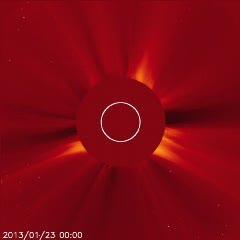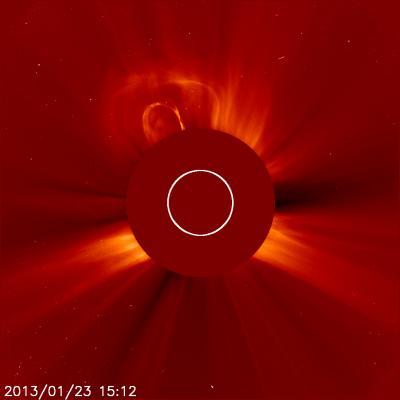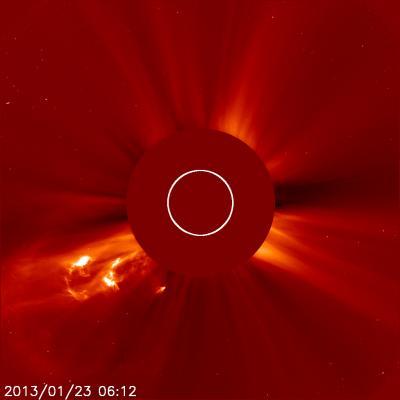Earth-directed CMEs can cause a space weather phenomenon called a geomagnetic storm, which occurs when they connect with the outside of the Earth's magnetic envelope, the magnetosphere, for an extended period of time. In the past, CMEs of this speed have not caused substantial geomagnetic storms. They sometimes cause auroras near the poles but are unlikely to affect electrical systems on Earth or interfere with GPS or satellite-based communications systems.
A slightly slower CME that was not Earth-directed, also erupted earlier in the day.

This movie shows two coronal mass ejections (CMEs) erupting from the sun on Jan. 23, 2013. The first was not directed at Earth; the second one is, but is not expected to have a strong impact. The movie was captured by the joint ESA/NASA mission the Solar and Heliospheric Observatory (SOHO), beginning at 7 p.m. EST on Jan. 22 and ending at 5:30 p.m. Jan. 23.
(Photo Credit: : ESA, NASA/SOHO/Goddard Space Flight Center)
NOAA's Space Weather Prediction Center is the United States government's official source for space weather forecasts.

The second of two coronal mass ejections (CMEs) on Jan. 23, 2013, is seen erupting in the top of the picture, away from the sun, which is obscured by the disk in the center. The Solar and Heliospheric Observatory captured this image, called a coronagraph: the bright light of the sun itself is blocked to provide a better view of the sun's atmosphere, the corona. This CME left the sun at speeds of 375 miles per second (1.35 million mph), which is almost 10 times lower than the very fastest CMEs.
(Photo Credit: : ESA, NASA/SOHO)

The first of two coronal mass ejections (CMEs) on Jan. 23, 2013, can be seen erupting in the lower left portion of this image, from the Solar and Heliospheric Observatory. This CME was not Earth-directed. This image is what's known as a coronagraph, in which the bright light of the sun itself is blocked in order to better see the sun's atmosphere, the corona.
(Photo Credit: : ESA, NASA/SOHO)
Source: NASA/Goddard Space Flight Center